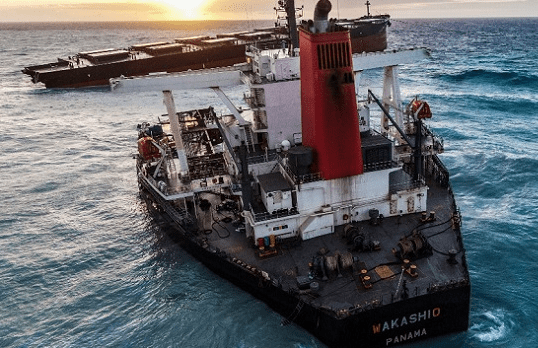Wakashio, the giant Capesize bulker which ran aground on a reef off Mauritius and subsequently split in two, causing a major fuel spill, diverted from its navigation route approaching closer to the coast of the island as the crew was trying to pick up an Internet signal.
These are the preliminary findings of an investigation into the incident by the Panama Maritime Authority, which has dispatched a delegation of experts to Mauritius.
The delegation is currently gathering information through face-to-face interviews with members of the ship’s crew.
The Japanese bulker Wakashio went aground off Mauritius on July 25. The bunker oil from the vessel leaked out on August 6, and the vessel broke apart on August 15.
The ship deviated from its approved navigation plan at the time of sailing from Singapore on the route approved by the captain and his deck officers, which would have taken them to their destination in a safe manner.
The captain of the ill-fated bulker ordered the change of course and instructed the ship to approach five miles away from the coast. The crew was trying to pick up a telephone or an Internet signal so they could get in touch with their families.
The Panama Maritime Authority said that the modification could also be linked to a birthday celebration of one of the crew members.
The findings further show that the captain, the chief engineer and the first officer were on the navigation bridge when the “improper approach” was taking place and were in a position to correct course and avoid the grounding after Mauritian authorities alerted them of the danger. However, they failed to do so.
Previous accounts from the Mauritian authorities indicate that they tried to get in contact with Wakashio prior to the grounding as the ship was sailing too close to the coast and were warning the vessel to turn back, but their calls were unanswered.
Furthermore, AMP reports that the crew seems to have used an inappropriate chart onboard with the wrong scale as well.
“The lack of supervision and monitoring of the navigation equipment, the distraction generated by the officer of watch, who lost the course of navigation completely, and the excess of confidence during the watch, could be some of the reasons that caused the ship running aground in the beaches of Mauritius,” the AMP pointed out.
“With an appropriate assessment safeguard and with good seamanship practices, that should have generated an analysis which would have allowed to carry out the pertinent actions to correct this situation.”
The maritime authority is resuming the investigation. Its delegation is expected to interview the captain, the first officer, and get access to the voyage data recorder (VDR) and essential documents for the investigation, which are in the custody of the Police of the Republic of Mauritius.
The Master and Chief Officer of the ill-fated vessel have been arrested and are facing criminal charges over the environmental disaster.

